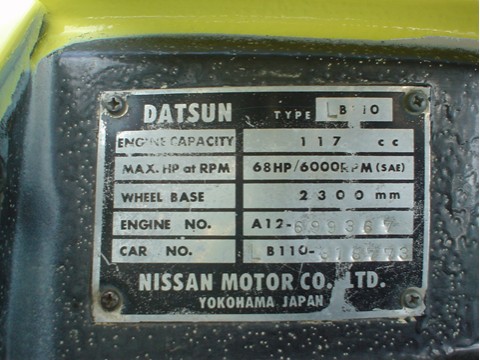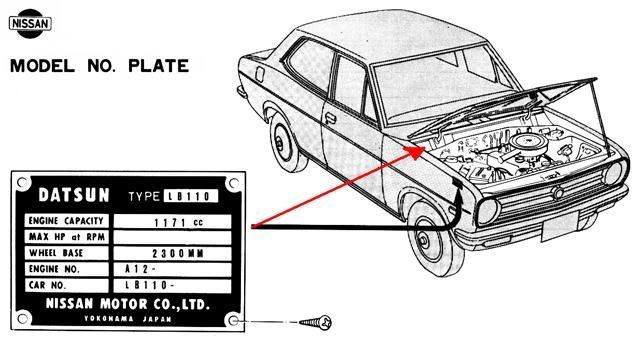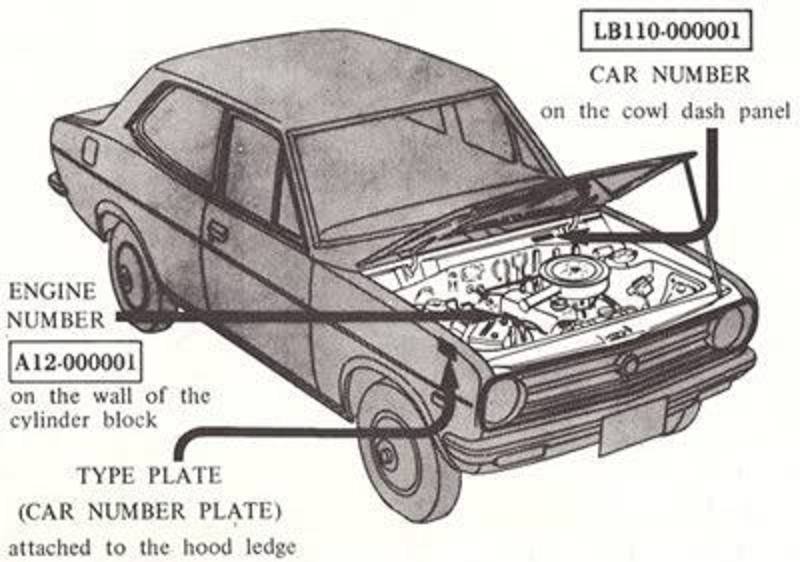| Revision as of 13:18, 31 October 2021 ddgonzal (Talk | contribs) <- Previous diff |
Revision as of 13:36, 31 October 2021 ddgonzal (Talk | contribs) Next diff -> |
||
| Line 33: | Line 33: | ||
| ** Check digit: 2 | ** Check digit: 2 | ||
| * [[Model year]]: B - 1981 | * [[Model year]]: B - 1981 | ||
| - | * Plant code: 9 - Fujiya | + | * [[#Plant_Codes|#Plant code]]: 9 - Fujiya |
| * Chassis no: 259790 | * Chassis no: 259790 | ||
| Line 44: | Line 44: | ||
| * VDS attributes: PB05S7 | * VDS attributes: PB05S7 | ||
| * [[Model year]]: C - 1982 | * [[Model year]]: C - 1982 | ||
| - | * Plant code: U - Fujiya | + | * [[#Plant_Codes|#Plant code]]: U - Fujiya |
| * Chassis no: 205723 | * Chassis no: 205723 | ||
| Line 52: | Line 52: | ||
| {{UploadPost|174_617e925217b76.jpg|496101}} | {{UploadPost|174_617e925217b76.jpg|496101}} | ||
| - | The Car Number is on the engine compartment aluminum ID plate, and the Car Number is also stamped into the body sheet metal just under the left bonnet hinge. | + | The Car Number is stamped onto the engine compartment aluminum ID plate. |
| + | <br>{{Album|12220}} | ||
| - | {{Album|12220}} | + | For more 1200 ID plates from various countries, see [[Chassis numbers]]. They all follow a similar format and location. |
| + | |||
| + | The plate is located either under the right bonnet hinge or forward of the right strut tower. | ||
| + | <br>{{UploadPost|174_5d40897c492f8.jpg|492035}} {{Album|20108}} | ||
| + | |||
| + | The Car Number is also stamped into the body sheet metal just under the left [[bonnet]] hinge. | ||
| = Japan Domestic Market = | = Japan Domestic Market = | ||
| Line 63: | Line 69: | ||
| * Chassis number: VPJC22-202948 | * Chassis number: VPJC22-202948 | ||
| - | This is not an ISO 3779 standard VIN but only a "Chassis Number". | + | This is not an ISO 3779 standard VIN but only a "Chassis Number", a Nissan-specific vehicle identification number. |
| EXAMPLE | EXAMPLE | ||
| Line 85: | Line 91: | ||
| * X Nissha-Hiratsuka 平塚 | * X Nissha-Hiratsuka 平塚 | ||
| * 4 Aichi Machine 愛知機械 | * 4 Aichi Machine 愛知機械 | ||
| - | * 5 Murayama (Prince Motors plant acrquired in merger Aug 1966, Production ceased Mar 2001) | + | * 5 Murayama (Prince Motors plant acquired in merger Aug 1966, Production ceased Mar 2001) |
| * 9 Fujijyu (Fujiya, Fuji) Sold December 1999 | * 9 Fujijyu (Fujiya, Fuji) Sold December 1999 | ||
Revision as of 13:36, 31 October 2021
Vehicle Identification Number
Also see: * Chassis numbers * Body Codes
Contents |
Overview
Starting in 1980, Datsuns for sale in North America were marked with an international-standard VIN number (Vehicle identification numberᵂ). Prior to 1980, the identification scheme that Nissan used was called the #Car Number.
Australia started using standard VIN for passenger cars January 1992 (Australian Design Rule 61/00 - Vehicle Marking).
You'll find the VIN in these locations:
- Engine compartment ID plate
- dash plate, visible through windshield
VIN, based on 1979 & 1980 ISO Standards, was the first international standardized vehicle identification number system. Prior to this, manufacturers used their own system. Nissan called their earlier IDs the "#Car Number". Since the 1981 calendar year, only the standardized VIN has been used in North America and Europe.
| Digits | 1-3 | 4-9 | 10 | 11 | 12-17 |
| N. America | Manufacturer Identifier | Vehicle Attributes | Model Year | Plant code | Manufacturer + chassis number |
| Int'l | Manufacturer Identifier | Vehicle Descriptor Section (VDS) | Model Year | Plant code | Unique chassis number |
Example
Here is a photo of actual B310 plate:VIN: JN1PB04S2B9259790 (17 digits) * WMI: JN1 ** J: Japan ** N: Nissan * VDS attributes: PB04S2 ** These are manufacturer-specific attributes ** Check digit: 2 * Model year: B - 1981 * #Plant code: 9 - Fujiya * Chassis no: 259790
EXAMPLE 2VIN: JN1PB05S7C7205723 (17 digits) * WMI: JN1 ** J: Japan ** N: Nissan * VDS attributes: PB05S7 * Model year: C - 1982 * #Plant code: U - Fujiya * Chassis no: 205723
Car Number
Prior to the 1980 VIN ISO Standard, Datsun used a vehicle identification number they called "Car Number".
The Car Number is stamped onto the engine compartment aluminum ID plate.

For more 1200 ID plates from various countries, see Chassis numbers. They all follow a similar format and location.
The plate is located either under the right bonnet hinge or forward of the right strut tower.


The Car Number is also stamped into the body sheet metal just under the left bonnet hinge.
Japan Domestic Market
For vehicles manufactured and sold by Japanese manufacturers for domestic use, the international VIN is not adopted but instead the Chassis Number identification scheme was used. In the 1980s they used combination of the chassis code (B121 or B122) and chassis serial number.
New Style
 * Chassis number: VPJC22-202948
* Chassis number: VPJC22-202948
This is not an ISO 3779 standard VIN but only a "Chassis Number", a Nissan-specific vehicle identification number.
EXAMPLEPlant 4: Aichi Machine Color 002: white (truck has been repainted) Trim K: gray
1970s Chassis Number
車台番号 B110-xxxxx

Plant Codes
- U Zama (Partial operations begin December 1964, production ceased May 1995)
- F Fuji Heavy Industries
- C Smyrna, Tennessee USA
- L Aguascaliente, Mexico
- M Tochigi (Completed March 1971)
- T Oppama (Partial operations begin Oct 1961)
- W Kyusyu 九州
- X Nissha-Hiratsuka 平塚
- 4 Aichi Machine 愛知機械
- 5 Murayama (Prince Motors plant acquired in merger Aug 1966, Production ceased Mar 2001)
- 9 Fujijyu (Fujiya, Fuji) Sold December 1999
For more details, see VINᵂ on wikipedia.

![[Datsun 1200 encyclopedia]](/wiki/upload/wiki.png)
